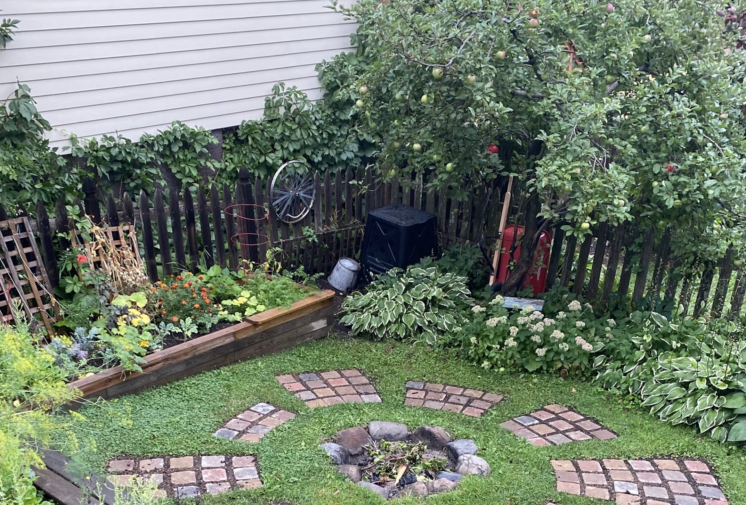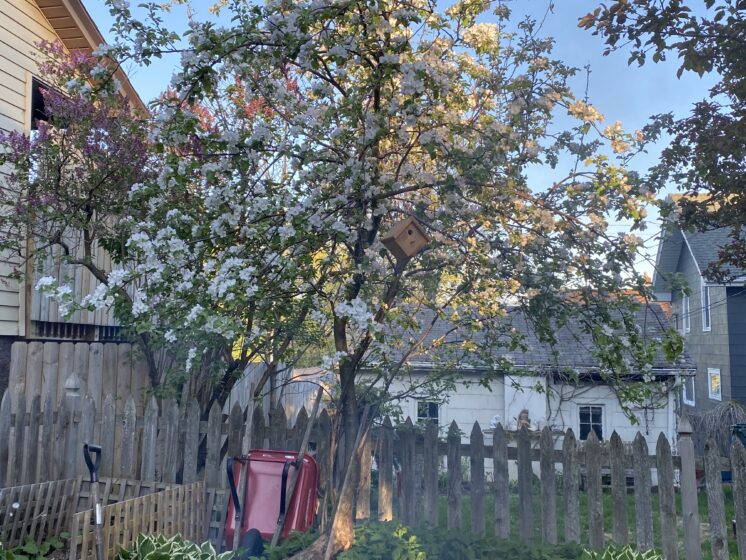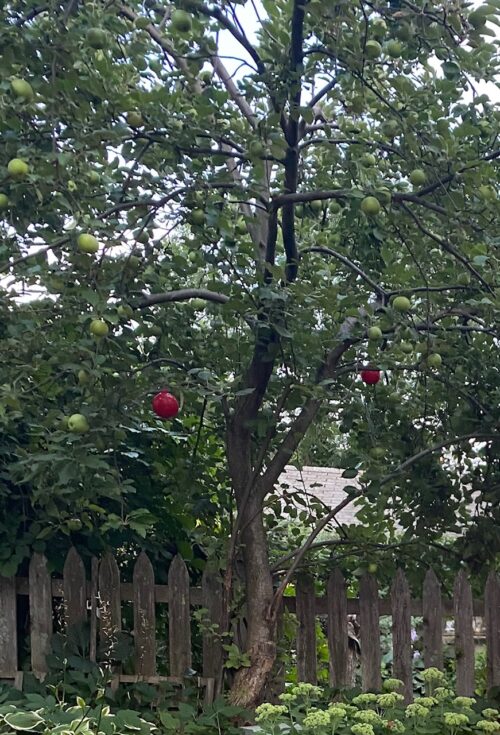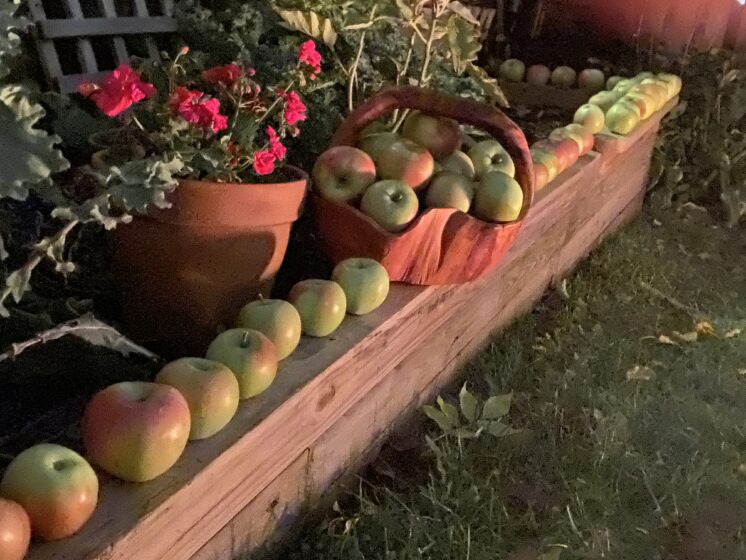How to prevent bad apples

This Duluth apple tree has brought many hours of joy to its owners. (September 2022 photo by Maija Jenson)
There is redemption for bad apples; at least for the apples on your backyard tree. You might have a bad apple tree of your own or just wonder “Are those apples on Skyline good to eat?” A little tree love and your Halloween party guests will be bobbing for apples they can actually eat.
I inherited my apple tree with my Duluth hillside home. That summer 100 apples ripened on my tree. I was thrilled. In the fall I made a pie from the best looking fruit, but sadly only a few were good. Most of the apples were infested with bugs that left little brown spots in the flesh. They were misshapen or scabbed.
I love our apple tree and plentiful seasons produce upward of 200 apples. But I grew tired of filling five-gallon buckets with lumpy apples and searching for takers like cider-makers, pig farmers or horse trainers. I wanted to eat my apples.
Experts
Faced with another year of bad apples, I found help from the University of Minnesota Extension. They share a calendar of how to care for your tree through the seasons. The University of Minnesota has been developing and growing apples for 145 years and shares basics and tips to improve your tree. I found the common brown wormy ones I despised have apple maggots. So I started there.
If you want to have a boom crop of worm-free apples next year, there are a few simple things you can do to make this more likely. Trim your tree, thin the apples, catch the apple maggots before they get to your apples and eliminate their pupate stage in the ground. It’s easier than it sounds.

The blooming apple trees foreshadows the bounty that lies ahead. Once your tree is in bloom, any additional trimming should wait and after flowering should be done with caution, clean tools and only if necessary.
Spring Tree Trimming
There are many online blogs and help to learn more about tree trimming. Trim your apple tree in early spring before buds appear, for sure before it is blooming. I trimmed mine in March but you just want it to be a little cold still to prevent bacteria in the fresh cuts. I get out the tree pruner, clean it well and follow the steps in the three U Extension videos. There are three rules. I just get in there with my loppers and follow the rules.
They say to:
- Trim any dead or damaged branches. I had rabbit issues to clean up in recent deep snow years.
- Trim off any water sprouts from around the base and any other vertical growing shoots coming up off the branches. This will help the tree grow out instead of up and put effort into the fruit-bearing branches.
- Trim off any crossing branches. Climb in under the tree, and look up. This will ensure that each branch gets the necessary light. It also will eliminate rubbing branches and overcrowding. Pick the stronger or better of the two crossing shoots and trim the other back to its source.
“Favor the branch that goes with the structure of the tree,” UMN Apple Research Scientist David Bedford said.
You don’t want to simply give it a haircut to take off length as you may trim off fruit-bearing buds.
Apple Maggots?
Dimpled or lumpy apples also likely have little brown specks in the flesh. These pests are apple maggots. I have been told they are fine to eat, but apple maggots … ew. Some folks will take them for cider; also ew.
Apple maggots grow in the ground in the spring and fly up to the red apples in June. They burrow in and live a happy life cycle in the apples, then fall to the ground and burrow in the dirt to pupate. It’s not complicated to stop them from getting to your apples and keep them out of the ground.
Remember to pick all the apples off your tree each fall. I use an apple picker on a stick, a short step ladder, kids on shoulders, garden benches … anything to get them all off the tree. Do not compost your apples. Either share them to feed animals (animals that live far away are best) or make cider, you do not want them decomposing anywhere near your tree.
Pick up and dispose of all apples on the ground because they are busy breeding next year’s maggots. Pick up all the apples or else the bugs will crawl out into the ground for winter, spawn and fly up into the fresh apples next summer. This important step interrupts the cycle, and you are well on your way. I try to keep up with “fallen” fruit from wild-animal interference throughout the fall.

The red Christmas ornament insect traps are doing their job. The apple maggots fly up seeking red apples, and these ones look like lunch. They pass over the green apples in favor of the trap.
Make a trap
In June, hang apple traps in the tree. I use two each year. They will lure any evasive apple maggots flying up to your young apples. The young bugs see red, so the traps are simply two bright red plastic balls covered in non-drying glue.
You can buy an apple maggot kit but I create my own. I use three or four inch Christmas ornament balls. I buy the clear ones from the craft store and spray paint them red. You can use ornament hooks to extend the hanger to fit the tree branch. I have accumulated a large stash because they are hard to find when it’s not the holiday season.
So by mid-June, turn them into fly paper and hang them in the tree. Paint the bottom 2/3 of the red balls with a non-drying insect trap glue like “Tangle-Trap Sticky Coating,” which costs under $10 and lasts for years.
Bird advocates say to never put non-drying glue traps outdoors because small birds can get stuck. This is possible and was concerning since we had wrens nesting in our tree. I investigated and modified my approach.
I found that two orchard owners shared on Reddit that they did trap one bird after 20 years of using 80+ traps each year. Just in case, I paint only the bottom 2/3 so if a bird or other creature steps or lands on the ball, they will not be trapped. I caught one bee and one moth over the years, but mostly a bunch of maggot flies the first two years, now mostly just mosquitos.
One cycle of this will show major improvement; Don’t let them burrow in the ground from fallen apples and trap the fresh spawn in the spring before they get to your apples. That’s the trick.
Grow better fruit
These next steps get a bit more labor intensive. Once you had worm-free apples, you might be enamored with your apple tree and inspired to put in more time and effort. In June when the apples are dime or nickel size, hand thin the apples. If the apples are growing in pairs from one sprout, pick the smaller of the apples.
“Thinning fruit off the trees by hand will minimize biennial bearing and promote larger, higher quality fruit,” said Jake Overguard, extension educator. “Leave one to two apples every six inches.”
You can also use this time of year to try one more apple maggot prevention method. If you have a low fruit year this is a good time to try out the bagging method. You can create a barrier to apple maggots infesting the new crop by putting a ziploc baggie on each apple. I did this once and bagged more than 30 apples.
Take a sandwich bag, snip the corner off so any water runs out. Put the apple in the bag and zip it shut. Staple it to keep it from unzipping. Wrapping individual fruit is a common method used world-wide and in particular for pears and other delicate fruit but is also used world-wide.
After 3 years of close attention
This year I picked 200 beautiful apples. I gave a bag of apples, enough for a pie and eating to 7 or 8 people. I brought apples to my students and I dried 10 batches in the dehydrator.
I still had 50 apples! I saved enough in the refrigerator for a Thanksgiving apple pie.
Now I have too many good apples. A problem I enjoy. The squirrels still get their fill, leaving endearing chipped apple piles on the garden bench. I love my apple tree.
I have heard sad stories of people in Duluth cutting down their apple tree because it was a nuisance. But just like people, when neglected, they can become a real problem. Give your tree a little love this summer and you will literally enjoy the fruits of your labor.
Spring blooms turn to a white carpet in the backyard by late May. It makes the yard cozy, shades the yard a bit and wraps the fire-pit in privacy.
No more bad apples.

Fall harvest 2023. Identifying what kind of apples you have is challenging. My apples resemble the cold-weather Wealthy apple, created in 1868 in Minnesota by Peter Gideon. The Wealthy is a cross between the Duchess of Oldenburg and Jonathan apples. (Photo by Maija Jenson)
Recommended Links:
Leave a Comment
Only registered members can post a comment , Login / Register Here












1 Comment
llinmpls
about 2 weeks ago